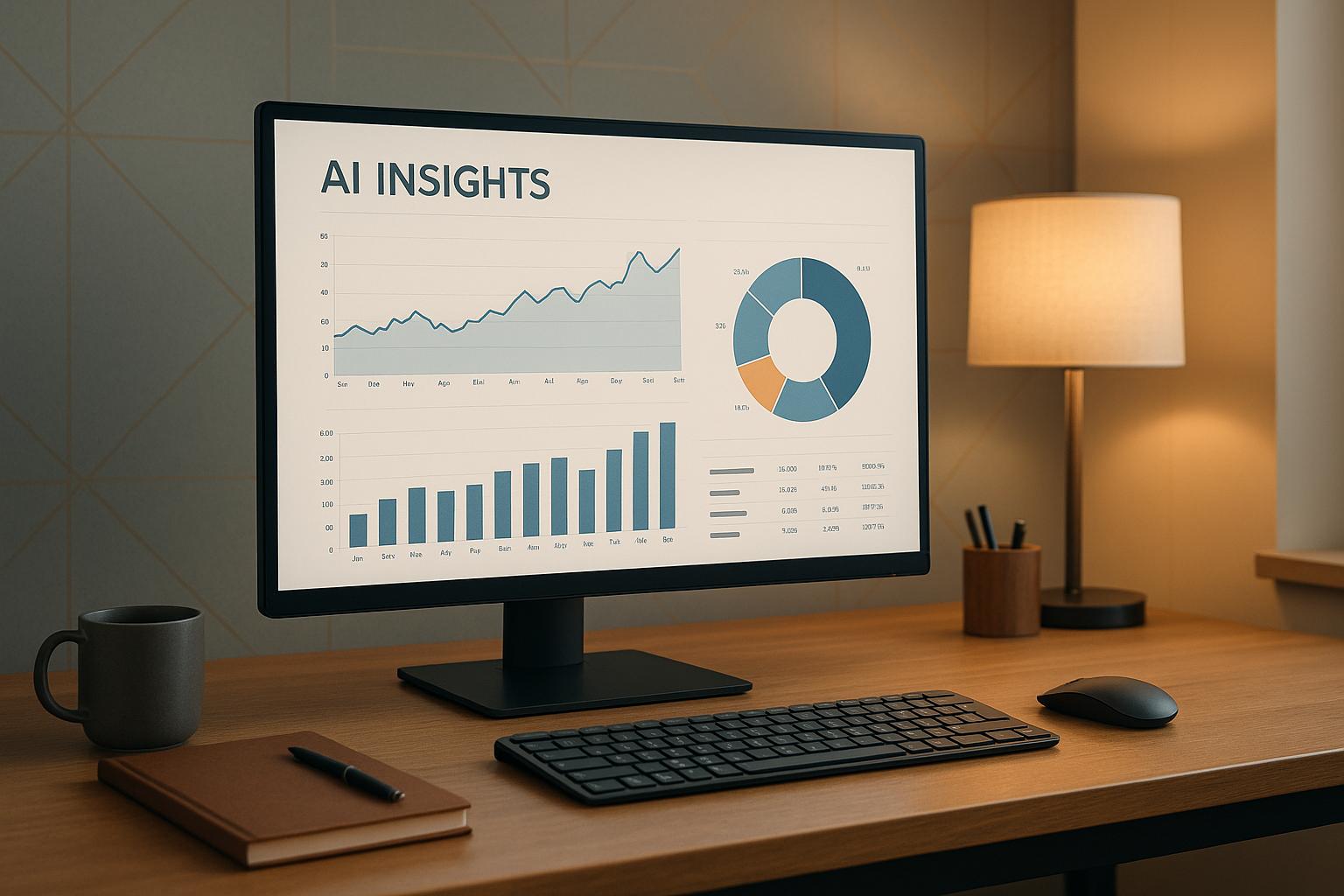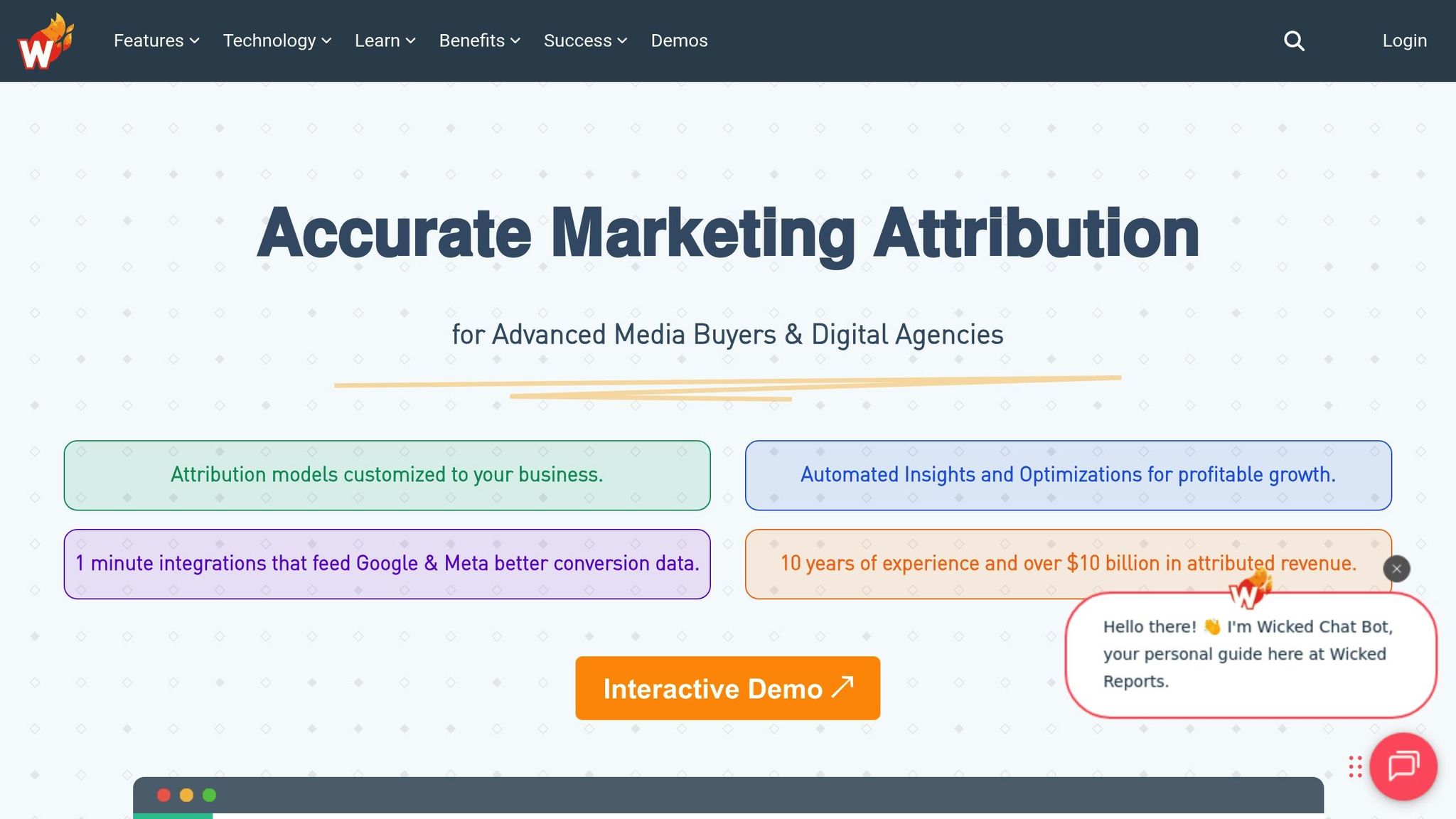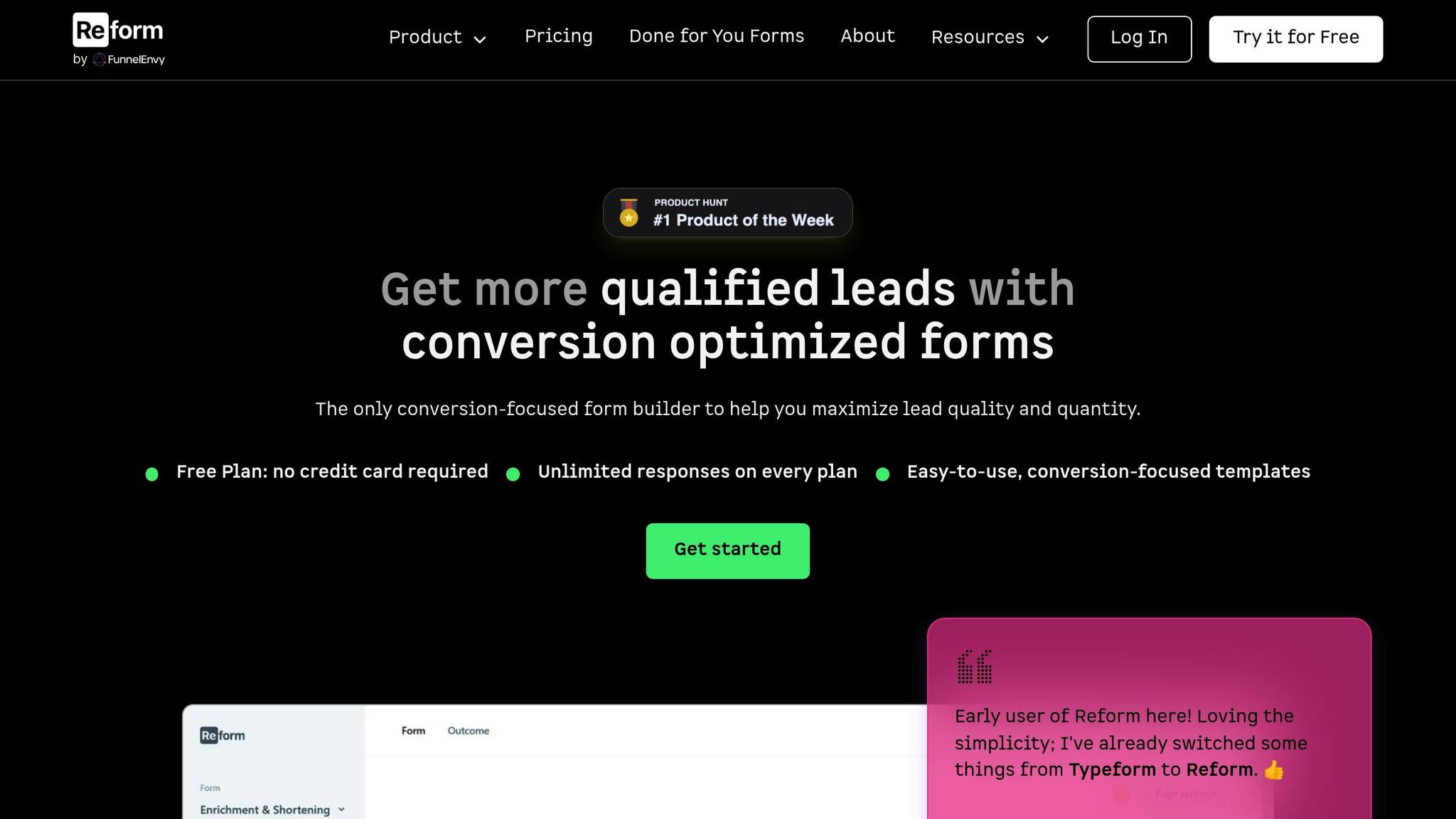AI Attribution Tools for B2B Marketers

AI attribution tools are transforming how B2B marketers measure and optimize their campaigns. These tools use machine learning to analyze buyer journeys, assign credit across multiple touchpoints, and provide actionable insights for better decision-making. Unlike outdated models like first-touch or last-touch attribution, AI-driven platforms offer a complete view of what drives conversions, helping marketers allocate resources effectively and improve collaboration with sales teams.
Key takeaways:
- Buyer Journeys: B2B sales cycles are long and involve multiple stakeholders and interactions. AI attribution simplifies tracking across channels like email, webinars, and sales calls.
- Benefits: Real-time analytics, smarter budget allocation, and improved marketing-sales alignment lead to higher ROI.
- Features to Look For: Multi-touch attribution models, real-time reporting, CRM integrations, and lead enrichment tools.
- Top Tools: Reform specializes in form-based lead data, while Windsor.ai excels at unifying data from 325+ sources for broader attribution insights.
AI attribution tools are essential for navigating the complexities of B2B marketing and driving measurable results. Whether optimizing campaigns or aligning teams, these platforms provide the clarity needed to make informed decisions and improve ROI.
Inside Wicked Reports: How to Use AI + Attribution to Scale Ads with Confidence

Core Features of AI Attribution Tools for B2B Marketing
Choosing the right AI attribution tool means knowing which features are essential for success in B2B marketing. The complexity of B2B buyer journeys - where prospects often engage with content multiple times before making a decision - requires tools with advanced tracking, real-time insights, and seamless data integration. Let’s break down the features that set effective AI attribution tools apart from standard analytics platforms.
Multi-Touch Attribution Models
In B2B marketing, relying on single-touch attribution models - where only one interaction gets credit - just doesn’t cut it. Prospects often interact with dozens of touchpoints before making a purchase. Multi-touch attribution models address this by assigning credit to multiple interactions, offering a clearer picture of what’s truly driving conversions.
For example, linear attribution splits credit evenly across all touchpoints, making it a simple option for shorter sales cycles. On the other hand, time decay models give more weight to interactions closer to the final conversion, better reflecting the nurturing process needed in longer cycles.
The most advanced option? Data-driven models. These leverage machine learning to analyze actual conversion data and assign credit based on the real influence of each touchpoint. Rather than relying on fixed rules, AI algorithms identify patterns across thousands of customer journeys to determine which combinations of interactions are most likely to lead to closed deals.
The payoff is significant. Multi-touch attribution models can boost marketing ROI by up to 30% compared to single-touch models. By understanding which activities drive revenue, marketers can double down on high-performing channels and cut back on underperforming ones. This level of insight allows for smarter resource allocation and better results.
But multi-touch insights are just the beginning. Real-time analytics take it a step further by enabling immediate campaign adjustments.
Real-Time Analytics and Reporting
Accurate attribution is only half the battle - real-time analytics ensure you can act on insights instantly. In fast-moving markets, waiting weeks for performance reports isn’t an option. Real-time analytics let marketers monitor campaigns as they happen, spot underperforming channels, and make adjustments on the fly.
With AI attribution tools, live dashboards update continuously as prospects engage with your marketing efforts. For instance, if a webinar suddenly drives a surge in registrations, you’ll see the results immediately and can adjust follow-up campaigns to capitalize on the momentum. Similarly, if an ad campaign stops delivering results, real-time data helps you pause spending before wasting resources.
This instant feedback transforms marketing into a dynamic process. Teams can test new messaging, tweak targeting, or refine strategies based on live performance data. Real-time analytics turn marketing from a “set it and forget it” approach into a system of constant optimization.
Reporting features go beyond basic metrics, too. Advanced platforms offer customizable dashboards that focus on the KPIs that matter most, such as revenue attribution, cost per qualified lead, and pipeline velocity. This level of detail supports faster, more informed decision-making, helping teams stay ahead in competitive markets.
CRM and Marketing Automation Integrations
To truly understand the customer journey, your AI attribution tool needs to integrate seamlessly with your CRM and marketing automation platforms. These integrations link marketing activities directly to sales outcomes, providing a unified view of customer data. Without them, attribution data exists in silos, making it harder to connect marketing efforts to revenue.
Strong integrations do more than just transfer data. Custom mapping ensures that leads flow accurately between systems. For example, if a prospect fills out a form using a tool like Reform, all relevant attribution details should automatically sync with your CRM.
Duplicate management is another critical feature. B2B prospects often interact with multiple touchpoints using different email addresses or contact details. Smart integrations identify and merge duplicate records, ensuring your database remains clean and your attribution models have complete, accurate data to work with.
For maximum flexibility, look for tools that support webhooks and APIs. These features allow you to connect your attribution platform with specialized or proprietary systems that may not have native integrations. This ensures you can collect data across your entire marketing stack, no matter how unique your setup is.
The result? Closed-loop reporting that ties marketing efforts directly to revenue. Sales teams gain valuable insights into which touchpoints resonate most with prospects, while marketers can clearly demonstrate ROI and refine campaigns based on what’s proven to work. These integrations complete the picture, empowering B2B marketers to make data-driven decisions and drive revenue with confidence.
Top AI Attribution Tools for B2B Marketers
AI attribution tools have transformed how marketers track and refine their strategies. These tools collect data at critical points in the customer journey, providing a complete view - from the first interaction to final conversion.
Overview of Reform for AI Attribution

Reform focuses on capturing high-quality data during key stages of the buyer's journey. While it’s not a full-fledged attribution platform, its advanced form capabilities make it an essential piece of the attribution puzzle.
The platform offers multi-step forms and lead enrichment features that gather detailed prospect information. It also segments leads automatically to enhance attribution efforts. For example, prospects who indicate they’re "ready to buy" are routed directly to sales, while others are guided toward educational content. This level of segmentation reveals which touchpoints are driving the most engagement.
Reform’s lead enrichment feature goes a step further by gathering additional data from the web, creating richer prospect profiles without compromising conversion rates. Real-time analytics provide immediate feedback on form performance, while integrated A/B testing ensures ongoing improvements in both conversion rates and data quality.
"Reform is what Typeform should have been: clean, native-feeling forms that are fast to deploy. Reform does the job without a bunch of ceremony."
– Derrick Reimer, Founder, SavvyCal
Seamless integration with CRM and marketing automation systems ensures that lead data flows smoothly across platforms. Reform also tracks abandoned form submissions, capturing partial data to identify friction points in the buyer’s journey. This detailed data collection supports effective multi-touch attribution models.
Other AI attribution tools complement Reform by focusing on broader data unification.
Other AI Attribution Tools
Windsor.ai stands out for its ability to integrate data from over 325 sources. It gathers and unifies information from marketing, sales, and business platforms to create a single source of truth. By turning raw data into actionable insights, Windsor.ai helps B2B marketers refine their campaigns with performance-driven strategies.
Comparison Table of AI Attribution Tools
Here’s a quick comparison of the key features offered by Reform and Windsor.ai:
| Tool | Attribution Models | Real-Time Analytics | Key Integrations | Lead Enrichment | Pricing Range | Best For |
|---|---|---|---|---|---|---|
| Reform | Optimizes single touchpoints | Yes | CRM, Marketing Automation, Zapier | Yes | $15–$35/month | Form conversion optimization |
| Windsor.ai | Data integration for attribution | Yes | 325+ marketing, sales, and business data sources | No | N/A | Comprehensive data unification |
The best attribution strategies often combine multiple tools. For instance, Reform excels at optimizing lead capture during critical conversion moments, while Windsor.ai provides a broader perspective by unifying diverse data sources.
"Reform is amazing! You all ship so fast and the design is absolutely fantastic. In the past I've always been apprehensive about sending a form but now I love it 👌"
– Corey Haines, Co-founder, Conversion Factory
sbb-itb-5f36581
Best Practices for Implementing AI Attribution in B2B Campaigns
Effectively using AI attribution tools in B2B campaigns demands thoughtful planning and execution. When done right, these tools can bridge the gap between marketing and sales teams, boost campaign performance, and drive revenue growth. Below, we’ll explore key practices that ensure a smooth transition from data collection to campaign optimization.
Setting Up Marketing and CRM Systems
To fully leverage AI attribution tools, start by integrating your marketing and CRM systems. Map data fields between your AI attribution platform, marketing automation platform (MAP), and CRM to maintain consistent tracking identifiers like email addresses or account IDs. Tools like HubSpot and Salesforce come with built-in integrations that make syncing data across platforms seamless, offering complete visibility from the first interaction to the final deal.
Automating data synchronization and conducting regular audits are essential to ensure no touchpoints - like form submissions, clicks, or website visits - are missed. Consistent use of tracking parameters such as UTM codes across campaigns further guarantees accurate data collection. Additionally, features like fraud detection and customizable attribution windows help filter out irrelevant interactions, preserving the quality of your data.
For example, in Q2 2025, monday CRM’s AI Blocks feature helped a mid-sized SaaS company automate data organization and lead routing. The result? A 28% increase in qualified leads and a 15% reduction in the sales cycle.
Using Attribution Data for Optimization
Attribution data provides a clear picture of which channels, campaigns, and touchpoints generate the most valuable conversions. This insight allows for smarter budget allocation and near-instant campaign adjustments, keeping your strategies flexible in a fast-changing market.
For instance, if reports show that prospects attending webinars are 40% more likely to request demos, you can tailor webinar content to address their needs and promote these events more strategically during the consideration phase. Advanced analytics tools can further refine these efforts, guiding tactical decisions.
Predictive analytics takes this a step further by identifying trends and suggesting adjustments before performance dips. Even small tweaks can have a big impact - like form optimizations, which have been shown to increase qualified leads by 215% in B2B and SaaS industries.
Aligning Marketing and Sales Teams
Collaboration between marketing and sales is critical, and shared attribution dashboards can serve as a unifying tool. These dashboards allow both teams to monitor progress, review reports together, and align their strategies. Platforms like Salesforce and Dreamdata offer dashboards that help clarify which activities are driving the sales pipeline.
Automated lead scoring further strengthens this collaboration by identifying high-intent prospects and routing them directly to sales, ensuring efforts focus on the most promising opportunities.
Revenue attribution also plays a key role in fostering teamwork. By clearly showing how each team contributes to the pipeline, it builds mutual respect and encourages cooperation. Multi-channel campaigns, when powered by AI, have been shown to deliver nearly five times the ROI of single-channel efforts, emphasizing the importance of tight coordination.
Finally, providing both teams with proper training and user-friendly tools ensures they can interpret attribution data effectively and make data-driven decisions that drive success.
Conclusion: The Future of AI Attribution in B2B Marketing
AI attribution tools are reshaping the way B2B marketers approach their campaigns. With buyer journeys becoming more intricate and spread across numerous touchpoints, these tools offer the clarity needed to make smarter, data-backed decisions that drive revenue growth.
The numbers speak volumes. Companies using AI-driven attribution models have reported conversion rates improving by over 18 times, while slashing their cost per acquisition by as much as 85%. These results highlight the competitive edge AI attribution provides in today's crowded B2B environment, underscoring the growing shift toward integrated, AI-powered strategies.
Take Reform, for example. Its no-code form builder not only captures high-quality leads but also enriches data seamlessly, ensuring every interaction is tracked and attributed accurately. This kind of precision lays the groundwork for better performance measurement and campaign optimization.
Looking ahead, the role of AI in Account-Based Marketing (ABM) is already showing massive potential. AI-powered ABM strategies are delivering 97% higher ROI compared to traditional methods. Multi-channel campaigns, supported by these tools, are achieving nearly five times higher ROI than single-channel efforts. These figures demonstrate how integrated attribution systems amplify success across the board.
The next wave of AI attribution tools promises even more. Real-time analytics and predictive insights are becoming standard, enabling marketers to tweak campaigns instantly based on live performance data. Deeper integration with CRM systems will create unified customer journey views, benefiting both marketing and sales teams.
For marketers still relying on traditional methods, the gap is growing fast. Without advanced attribution models, it’s nearly impossible to fully understand the complex B2B buyer journey - one that involves multiple stakeholders, extended timelines, and countless digital interactions.
In today’s data-driven world, AI attribution tools are no longer a luxury - they’re a necessity. Whether through comprehensive platforms or specialized tools like Reform for lead capture and enrichment, investing in these technologies is critical for staying ahead in an increasingly competitive market. B2B marketers who embrace AI attribution now will be the ones setting the pace in the future.
FAQs
How can AI attribution tools improve collaboration between marketing and sales teams in B2B organizations?
AI attribution tools play a key role in improving collaboration between marketing and sales teams by delivering data-backed insights into customer actions and campaign effectiveness. These tools pinpoint which marketing efforts are leading to conversions, helping both teams align their strategies and prioritize activities that yield the best results.
With features like real-time analytics and straightforward attribution models, these tools empower marketers to share actionable information with sales teams - such as the quality of leads and their engagement levels. This streamlined communication ensures both teams stay on the same page, work toward common objectives, and enhance the efficiency of the sales funnel.
What are the benefits of using multi-touch attribution models instead of single-touch models in B2B marketing?
Multi-touch attribution models offer a broader perspective on your marketing efforts by analyzing and assigning credit to multiple interactions throughout the customer journey. Unlike single-touch models that only highlight one touchpoint - like the first or last interaction - multi-touch models reveal how different channels and campaigns work together to drive conversions.
This method is particularly useful in B2B marketing, where the buying process tends to be longer and involves several decision-makers. With multi-touch attribution, you can make smarter decisions about where to allocate resources, fine-tune campaigns using actionable insights, and boost ROI by pinpointing the strategies that genuinely impact your audience at every stage of the funnel.
How do AI-powered real-time analytics enhance the success of marketing campaigns?
AI-driven real-time analytics give marketers the ability to see what's resonating and what’s falling flat - right as it happens. These instant insights into user behavior mean you can tweak campaigns on the fly, making them perform better and connect more effectively with your audience.
By analyzing real-time data, you can monitor how users interact with forms, identify emerging trends, and fine-tune critical elements like messaging or design. This not only boosts engagement but also improves conversion rates. Acting on insights immediately ensures your campaigns remain timely and impactful.
Related Blog Posts
Get new content delivered straight to your inbox

The Response
Updates on the Reform platform, insights on optimizing conversion rates, and tips to craft forms that convert.
Drive real results with form optimizations
Tested across hundreds of experiments, our strategies deliver a 215% lift in qualified leads for B2B and SaaS companies.


.webp)



